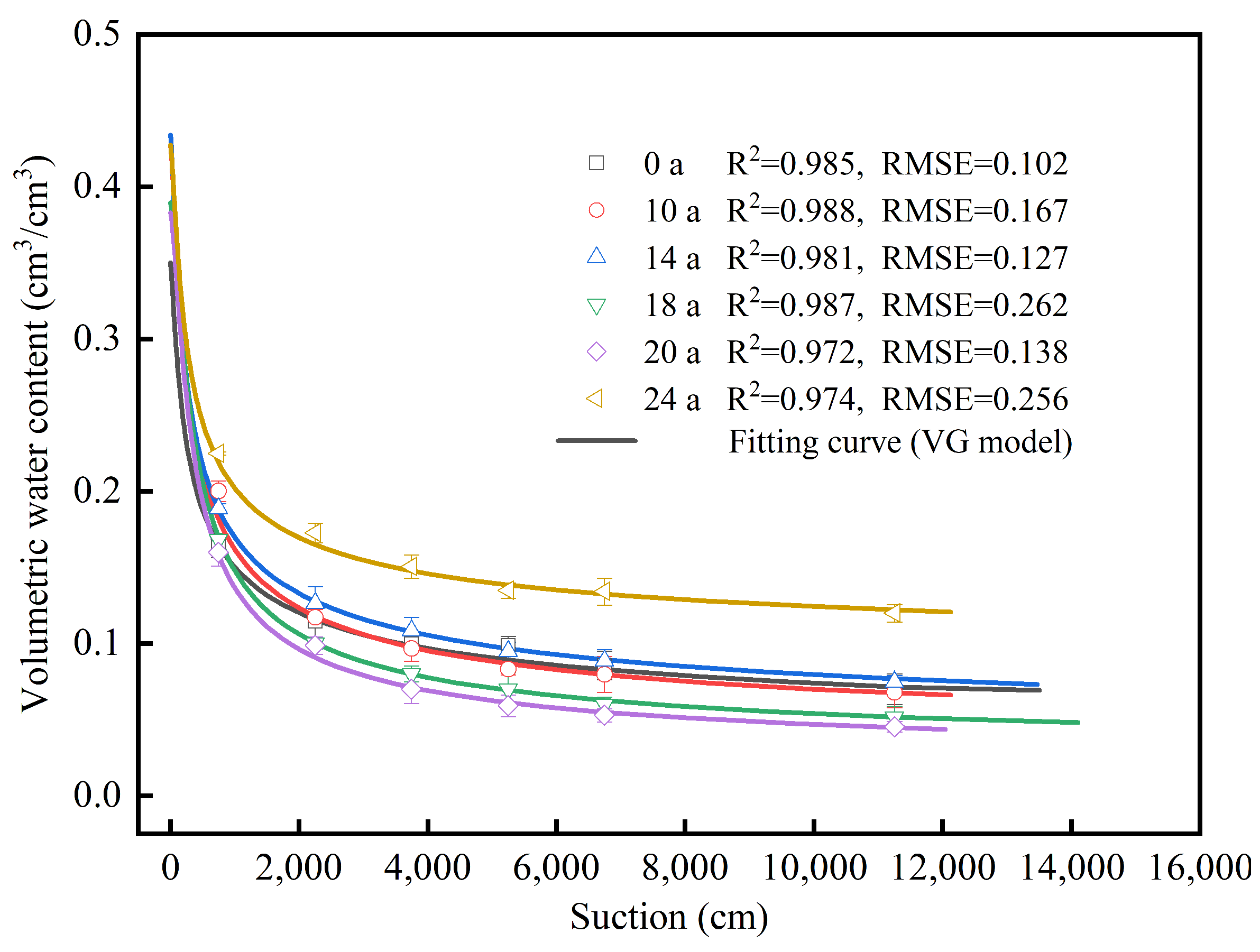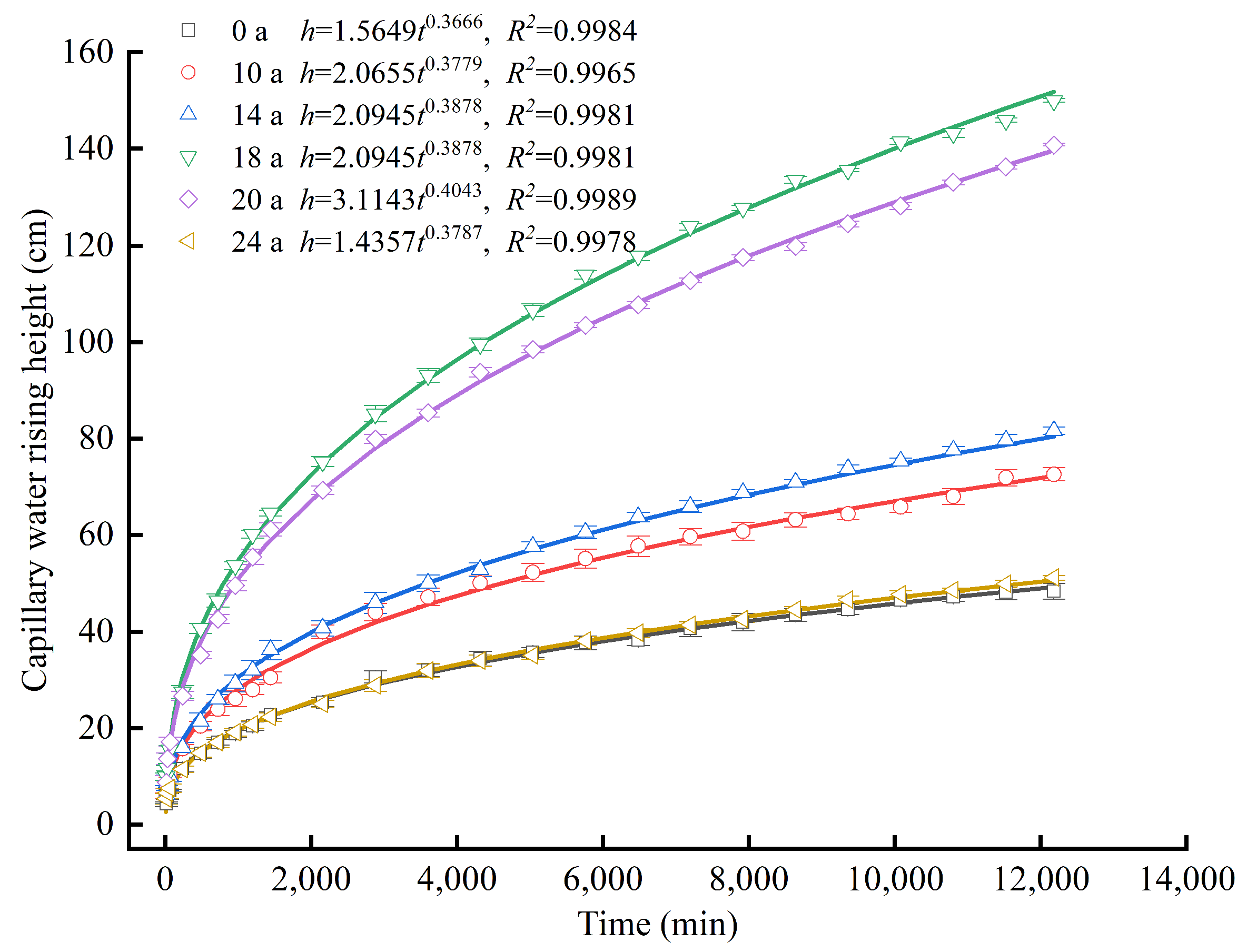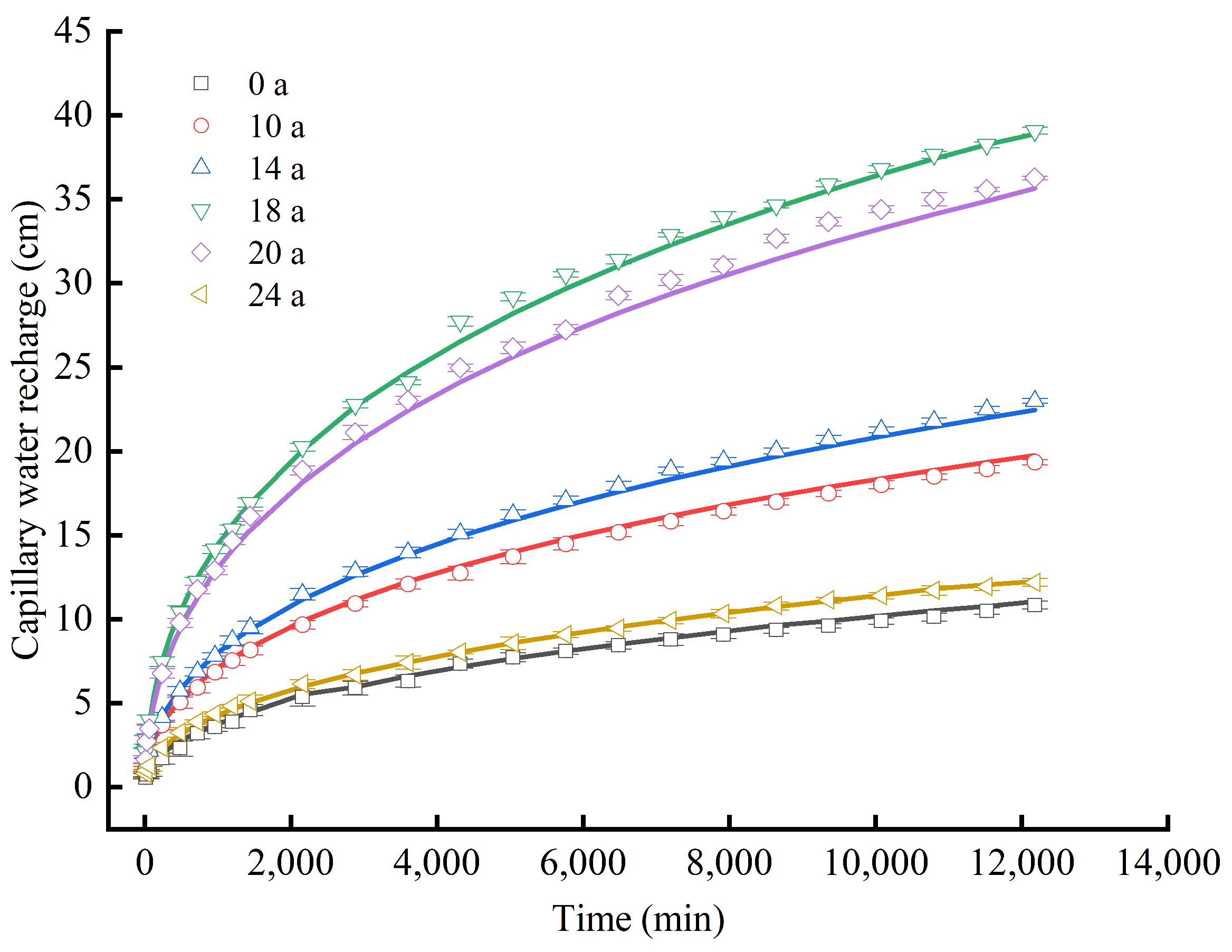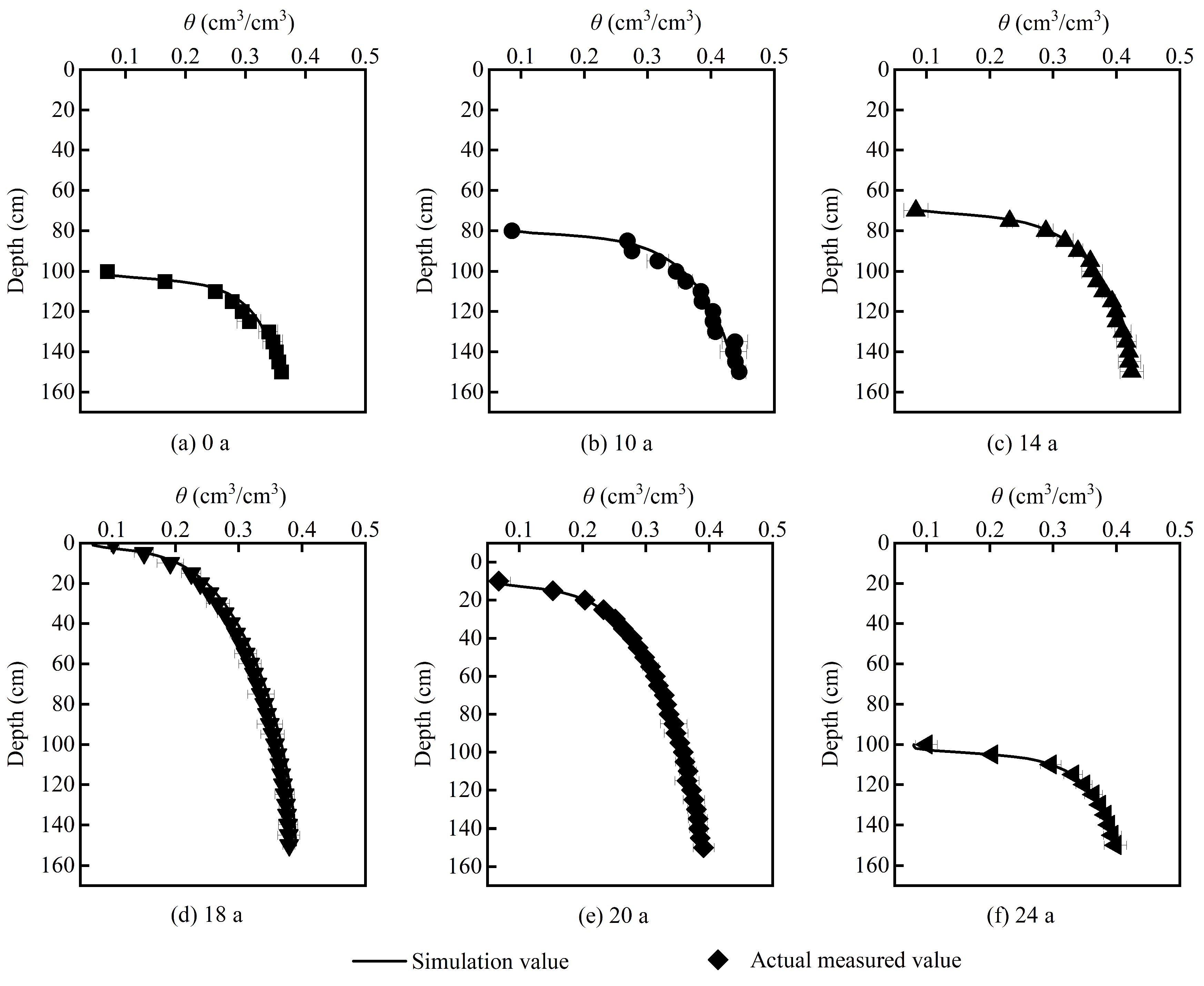Influence of Long-Term Mulched Drip Irrigation on Upward Capillary Water Movement Characteristics in the Saline–Sodic Region of Northwest China
Abstract
1. Introduction
2. Materials and Methods
2.1. Site Description and Soil Sample
2.2. Experimental Design
2.3. HYDRUS-1D Model
2.3.1. The Basic Equations of Water Motion, the Initial Conditions, and the Boundary Conditions
2.3.2. Soil Hydraulic Characteristics Determination
2.4. Data Analysis
3. Results and Discussion
3.1. Soil Hydraulic Characteristic Parameters
3.2. The Influence of MDI Application Years on the Movement Characteristics of Capillary Water
3.2.1. Wetting Front
3.2.2. Capillary Water Recharge and Rising Rate
3.3. The Process of Capillary Water Rise Simulated by HYDRUS-1D
3.4. The Relationship between Capillary Water Recharge and Wetting front Migration
3.5. Soil Profile Moisture Content Distribution
4. Conclusions
Author Contributions
Funding
Data Availability Statement
Conflicts of Interest
References
- Rao, Y.; Peng, T.; Xue, S. Mechanisms of plant saline-alkaline tolerance. J. Plant Physiol. 2023, 281, 153916. [Google Scholar] [CrossRef] [PubMed]
- Wang, J.; Du, G.; Tian, J.; Jiang, C.; Zhang, Y.; Zhang, W. Mulched drip irrigation increases cotton yield and water use efficiency via improving fine root plasticity. Agric. Water Manag. 2021, 255, 106992. [Google Scholar] [CrossRef]
- Kroes, J.; Supit, I.; van Dam, J.; van Walsum, P.; Mulder, M. Impact of capillary rise and recirculation on simulated crop yields. Hydrol. Earth Syst. Sci. 2018, 22, 2937–2952. [Google Scholar] [CrossRef]
- Yang, T.; Ala, M.; Guan, D.; Wang, A. The Effects of Groundwater Depth on the Soil Evaporation in Horqin Sandy Land, China. Chin. Geogr. Sci. 2021, 31, 727–734. [Google Scholar] [CrossRef]
- Chen, S.; Mao, X.; Shang, S. Response and contribution of shallow groundwater to soil water/salt budget and crop growth in layered soils. Agric. Water Manag. 2022, 266, 107574. [Google Scholar] [CrossRef]
- Liu, W.J.; Wu, J.H.; Pei, Q.B.; Zhang, T. Experimental Research on Capillary Water Upward Movement in Homogeneous Soil Under Different Ground Water Tables. J. Water Resour. Water Eng. 2010, 21, 67–69. [Google Scholar]
- Wu, Y.; Liu, T.; Paredes, P.; Duan, L.; Pereira, L.S. Water use by a groundwater dependent maize in a semi-arid region of Inner Mongolia: Evapotranspiration partitioning and capillary rise. Agric. Water Manag. 2015, 152, 222–232. [Google Scholar] [CrossRef]
- Soppe, R.W.O.; Ayars, J.E. Characterizing ground water use by safflower using weighing lysimeters. Agric. Water Manag. 2003, 60, 59–71. [Google Scholar] [CrossRef]
- Han, M.; Zhao, C.; Šimůnek, J.; Feng, G. Evaluating the impact of groundwater on cotton growth and root zone water balance using Hydrus-1D coupled with a crop growth model. Agric. Water Manag. 2015, 160, 64–75. [Google Scholar] [CrossRef]
- Yin, J.; Fei, L.; Cheng, D. Laboratory experiment on characteristics of capillary water upward movement from homogeneous soil. Trans. Chin. Soc. Agric. Eng. 2007, 23, 91–94. [Google Scholar]
- He, K.; Fei, L.; Yin, J. Rising Capillary Water Transport Characteristics of Homogeneous Soil. J. Shenyang Agric. Univ. 2007, 38, 581. [Google Scholar]
- Yuan, Y.Q.; Zhao, L.M.; Li, W.; Cao, R.C. Research on Silty Soil Capillary Water Rising in Yellow River Flooded Area of Eastern Henan. J. Highw. Transp. Res. Dev. 2016, 10, 40–46. [Google Scholar] [CrossRef]
- Guo, Q.; Li, X.; Li, M. Comprehensive tests on rising height of capillary water for coarse grained soil. Glob. Geol. 2013, 16, 54–58. [Google Scholar]
- Yang, H.Z.; Kan, C.Q.; Mao, X.H. Affection of Capillary Water Rising Height Which Made by the Layer Aquasorb Dosage. Water Sci. Eng. Technol. 2013, 05, 68–71. [Google Scholar]
- Pan, W.S.; Lu, Y.D.; Guo, J.Y. The Characters of the Capillary Water Rise and its Ecological Significance in Desert Lake-Basin Region, Northwest China. Adv. Mater. Res. 2014, 955–959, 3671–3677. [Google Scholar] [CrossRef]
- Stenitzer, E.; Diestel, H.; Zenker, T.; Schwartengraeber, R. Assessment of Capillary Rise from Shallow Groundwater by the Simulation Model SIMWASER Using Either Estimated Pedotransfer Functions or Measured Hydraulic Parameters. Water Resour. Manag. 2007, 21, 1567–1584. [Google Scholar] [CrossRef]
- Li, P.; Pan, Y.-h.; He, F.-h.; Tian, L.-l.; Ji, S.-x. Research on Capillary Water Absorption Characteristics of Yellow River Delta Wetland Soil. Chin. J. Agrometeorol. 2017, 38, 378–387. [Google Scholar]
- Zhang, P.; Wu, H.; Yin, H.J. Effect of particle size distribution on capillary water upward movement. Water Sav. Irrig. 2010, 7, 24–26. [Google Scholar]
- Lv, Q.L.; Yang, H.H. Pore structure characteristics of different soils and analysis of capillary water rising law. China Energy Environ. Prot. 2019, 41, 102–106. [Google Scholar]
- Li, X.; Zhou, J.; Zhao, Y.; Liu, Y. Effects of high-TDS on capillary rise of phreatic water in sand soil. Nongye Gongcheng Xuebao/Trans. Chin. Soc. Agric. Eng. 2011, 27, 84–89. [Google Scholar]
- Wang, D.; Fei, L. Rising Capillary Water Transported Characteristics of Layered Soil. Ground Water 2009, 31, 35–37. [Google Scholar]
- Xing, X.; Li, X.; Ma, X. Capillary rise and saliferous groundwater evaporation: Effects of various solutes and concentrations. Hydrol. Res. 2019, 50, 517–525. [Google Scholar] [CrossRef]
- Khorshidi, M.; Lu, N.; Akin Idil, D.; Likos William, J. Intrinsic Relationship between Specific Surface Area and Soil Water Retention. J. Geotech. Geoenviron. Eng. 2017, 143, 04016078. [Google Scholar] [CrossRef]
- Zhong, Y.; Fei, L.; Fu, Y.; Chen, L.; Liu, L. HYDRUS simulation and verification of movement characteristics of upward capillary water flow in soil as affected by multi-factor. Trans. Chin. Soc. Agric. Eng. 2018, 34, 83–89. [Google Scholar] [CrossRef]
- Chen, L.; Fei, L.; Fu, Y.; Wang, Z.; Zhong, Y. Simulation and Verification of Movement Characteristics of Upward Capillary Water Flow of Saline Water in Soils with Different Soil Temperatures and Bulk Densities Using HRDRUS. J. Soil Water Conserv. 2018, 32, 87–96. [Google Scholar]
- Zhang, Q.; Chen, W.; Wu, G.; Wang, W.; Du, Y.; Bi, J. Effect of PVA-treated soil on water-salt capillary rise in loess soil: Soil column experiment. J. Hydrol. 2022, 610, 127806. [Google Scholar] [CrossRef]
- Shokri-Kuehni, S.M.S.; Raaijmakers, B.; Kurz, T.; Or, D.; Helmig, R.; Shokri, N. Water Table Depth and Soil Salinization: From Pore-Scale Processes to Field-Scale Responses. Water Resour. Res. 2020, 56, e2019WR026707. [Google Scholar] [CrossRef]
- Pickett, S.T.A. Space-for-Time Substitution as an Alternative to Long-Term Studies. In Long-Term Studies in Ecology: Approaches and Alternatives; Likens, G.E., Ed.; Springer: New York, NY, USA, 1989; pp. 110–135. [Google Scholar]
- Wang, Z.; Fan, B.; Guo, L. Soil salinization after long-term mulched drip irrigation poses a potential risk to agricultural sustainability: Soil salinization under mulched drip irrigation. Eur. J. Soil Sci. 2019, 70, 20–24. [Google Scholar] [CrossRef]
- Tan, M.; Li, W.; Zong, R.; Li, X.; Han, Y.; Luo, P.; Dhital, Y.P.; Lin, H.; Li, H.; Wang, Z. Long-term mulched drip irrigation enhances the stability of soil aggregates by increasing organic carbon stock and reducing salinity. Soil Tillage Res. 2024, 240, 106069. [Google Scholar] [CrossRef]
- Zhang, A.; Wang, Z.H.; Wang, J.L.; Li, W.H. Influence of ground water on soil water and salinity distribution under the condition of evaporation. Agric. Res. Arid. Areas 2015, 33, 229–233. [Google Scholar]
- Šimůnek, J.; Šejna, M.; Saito, H.; Sakai, M.; Genuchten, M.T.V. The HYDRUS-1D Software Package for Simulating the One-Dimensional Movement of Water, Heat, and Multiple Solutes in Variably-Saturated Media; University of California-Riverside Research Reports; United States Salinity Laboratory, Agricultural Research Service, U.S. Department of Agriculture: Riverside, CA, USA, 2008. [Google Scholar]
- Tan, X.; Shao, D.; Liu, H.; Yang, F.; Xiao, C.; Yang, H. Effects of alternate wetting and drying irrigation on percolation and nitrogen leaching in paddy fields. Paddy Water Environ. 2013, 11, 381–395. [Google Scholar] [CrossRef]
- Yang, C.; Wu, J.; Li, P.; Wang, Y.; Yang, N. Evaluation of Soil-Water Characteristic Curves for Different Textural Soils Using Fractal Analysis. Water 2023, 15, 772. [Google Scholar] [CrossRef]
- Dou, X.; Shi, H.; Li, R.; Miao, Q.; Yan, J.; Tian, F.; Wang, B. Simulation and evaluation of soil water and salt transport under controlled subsurface drainage using HYDRUS-2D model. Agric. Water Manag. 2022, 273, 107899. [Google Scholar] [CrossRef]
- Jiang, L.; Wu, H.; Alfieri, L.; Li, X.; Kimball, J.S.; Chen, X. Review of Regionalization and Remote Sensing Based Method for Hydrological Model Parameters Calibration in Ungauged Basins. Acta Sci. Nat. Univ. Pekin. 2020, 56, 1152–1164. [Google Scholar] [CrossRef]
- Eyo, E.U.; Ng’ambi, S.; Abbey, S.J. An overview of soil–water characteristic curves of stabilised soils and their influential factors. J. King Saud Univ.-Eng. Sci. 2022, 34, 31–45. [Google Scholar] [CrossRef]
- Ju, X.; Gao, L.; She, D.; Jia, Y.; Pang, Z.; Wang, Y. Impacts of the soil pore structure on infiltration characteristics at the profile scale in the red soil region. Soil Tillage Res. 2024, 236, 105922. [Google Scholar] [CrossRef]
- Zong, R.; Wang, Z.; Li, W.; Li, H.; Ayantobo, O.O. Effects of practicing long-term mulched drip irrigation on soil quality in Northwest China. Sci. Total Environ. 2023, 878, 163247. [Google Scholar] [CrossRef] [PubMed]
- Huang, T.; Wang, Z.; Guo, L.; Li, H.; Tan, M.; Zou, J.; Zong, R.; Dhital, Y.P. The Impact of Long-Term Mulched Drip Irrigation on Soil Particle Composition and Salinity in Arid Northwest China. Agronomy 2024, 14, 599. [Google Scholar] [CrossRef]
- Dai, J.; Dong, H. Intensive cotton farming technologies in China: Achievements, challenges and countermeasures. Field Crops Res. 2014, 155, 99–110. [Google Scholar] [CrossRef]
- Bao, W.; Bai, Y.; Zhao, Y.; Zhang, X.; Wang, Y.; Zhong, Y. Effect of Biochar on Soil Water Infiltration and Water Holding Capacity in the Arid Regions of Middle Ningxia. Chin. J. Soil Sci. 2018, 49, 1326–1332. [Google Scholar]






| Application Years | Soil Bulk Density | pH | Organic Matter | Total Carbon | Soil Salt Content | Soil Fraction/% | ||
|---|---|---|---|---|---|---|---|---|
| a | (g cm−³) | (g kg−1) | (g kg−1) | (g kg−1) | Sand | Silt | Clay | |
| 0.02–2 mm | 0.002–0.02 mm | <0.002 mm | ||||||
| 0 | 1.70 ± 0.08 | 8.90 ± 0.01 | 10.21 ± 2.01 | 5.22 ± 0.68 | 7.72 ± 0.10 | 25.75 ± 2.96 | 47.80 ± 3.63 | 26.50 ± 1.33 |
| 10 | 1.46 ± 0.04 | 8.70 ± 0.09 | 11.25 ± 1.03 | 8.51 ± 0.61 | 7.89 ± 0.74 | 19.25 ± 2.85 | 48.36 ± 3.99 | 32.39 ± 1.21 |
| 14 | 1.45 ± 0.03 | 8.61 ± 0.05 | 13.82 ± 1.24 | 10.32 ± 0.60 | 6.83 ± 1.06 | 22.23 ± 2.98 | 42.36 ± 4.23 | 35.41 ± 1.46 |
| 18 | 1.48 ± 0.05 | 8.54 ± 0.08 | 14.56 ± 1.25 | 12.85 ± 1.29 | 6.60 ± 0.48 | 22.37 ± 3.10 | 56.37 ± 4.10 | 21.26 ± 0.99 |
| 20 | 1.51 ± 0.03 | 8.36 ± 0.09 | 15.41 ± 2.59 | 11.16 ± 1.31 | 1.53 ± 1.13 | 20.47 ± 3.43 | 61.24 ± 4.98 | 18.19 ± 1.04 |
| 24 | 1.60 ± 0.07 | 8.33 ± 0.05 | 14.41 ± 2.59 | 13.11 ± 2.17 | 2.72 ± 1.19 | 21.26 ± 3.50 | 42.97 ± 4.35 | 35.87 ± 1.18 |
| Application Years (a) | θr (cm3 cm−3) | θs (cm3 cm−3) | KS (cm min−1) | ||
|---|---|---|---|---|---|
| 0 | 0.0214 ± 0.012 ab | 0.350 ± 0.019 a | 0.0106 ± 0.001 b | 1.392 ± 0.002 c | 0.00176 ± 0.001 a |
| 10 | 0.0251 ± 0.008 ab | 0.428 ± 0.008 b | 0.0089 ± 0.002 a | 1.488 ± 0.004 b | 0.00475 ± 0.000 b |
| 14 | 0.0278 ± 0.010 a | 0.434 ± 0.013 b | 0.0106 ± 0.005 b | 1.441 ± 0.002 bc | 0.00490 ± 0.003 b |
| 18 | 0.0219 ± 0.007 ab | 0.390 ± 0.008 ab | 0.0057 ± 0.002 c | 1.602 ± 0.005 a | 0.00870 ± 0.006 c |
| 20 | 0.0177 ± 0.002 b | 0.383 ± 0.015 ab | 0.0059 ± 0.001 c | 1.619 ± 0.003 a | 0.00755 ± 0.002 c |
| 24 | 0.0237 ± 0.007 a | 0.395 ± 0.007 ab | 0.0113 ± 0.001 ab | 1.382 ± 0.001 c | 0.00219 ± 0.004 a |
| Application Years a | (cm min−1) | (cm min−1) | (cm min−1) |
|---|---|---|---|
| 0 | 0.0243 ± 0.0408 b | 0.0016 ± 0.0001 a | 0.0224 ± 0.0395 b |
| 10 | 0.0453 ± 0.0678 ab | 0.0029 ± 0.0007 b | 0.0333 ± 0.0604 ab |
| 14 | 0.0466 ± 0.0699 ab | 0.0032 ± 0.0006 c | 0.0362 ± 0.0636 ab |
| 18 | 0.0773 ± 0.1117 a | 0.0062 ± 0.0009 d | 0.0618 ± 0.1029 a |
| 20 | 0.0721 ± 0.1054 a | 0.0056 ± 0.0009 e | 0.0576 ± 0.0970 a |
| 24 | 0.0311 ± 0.0507 b | 0.0017 ± 0.0003 a | 0.0247 ± 0.0464 b |
| MDI Application Years | Rising Height | Recharge | |||||
|---|---|---|---|---|---|---|---|
| R2 | RMSE | MAE | R2 | RMSE | MAE | PBIAS | |
| 0 a | 0.991 ± 0.019 | 1.206 ± 0.297 | 1.016 ± 0.2675 | 0.998 ± 0.014 | 0.345 ± 0.155 | 0.172 ± 0.145 | −2.680 ± 0.465 |
| 10 a | 0.999 ± 0.009 | 1.884 ± 0.291 | 1.578 ± 0.244 | 0.991 ± 0.011 | 0.355 ± 0.164 | 0.371 ± 0.178 | −2.173 ± 0.104 |
| 14 a | 0.996 ± 0.012 | 1.584 ± 0.235 | 1.331 ± 0.166 | 0.994 ± 0.01 | 0.396 ± 0.106 | 0.352 ± 0.091 | 1.512 ± 0.115 |
| 18 a | 0.995 ± 0.008 | 1.650 ± 0.199 | 1.369 ± 0.146 | 0.996 ± 0.002 | 0.502 ± 0.099 | 0.409 ± 0.079 | 0.912 ± 0.065 |
| 20 a | 0.998 ± 0.013 | 1.541 ± 0.158 | 1.223 ± 0.133 | 0.995 ± 0.003 | 0.746 ± 0.184 | 0.659 ± 0.180 | 2.737 ± 0.150 |
| 24 a | 0.995 ± 0.018 | 1.046 ± 0.305 | 0.895 ± 0.299 | 0.993 ± 0.012 | 0.258 ± 0.089 | 0.231 ± 0.085 | 0.236 ± 0.082 |
| MDI Application Years | Liner Fitting | HYDRUS Fitting | Relative Error | ||
|---|---|---|---|---|---|
| a | % | ||||
| 0 | 4.5971 ± 0.0017 | 0.9661 | 4.6794 | 0.9957 | −1.7694 ± 0.0679 |
| 10 | 4.1533 ± 0.0024 | 0.9882 | 4.2412 | 0.998 | −2.0875 ± 0.0675 |
| 14 | 3.2310 ± 0.0012 | 0.9734 | 3.1836 | 0.997 | 1.4899 ± 0.0437 |
| 18 | 3.8151 ± 0.0016 | 0.997 | 3.7746 | 0.996 | 1.0686 ± 0.0465 |
| 20 | 3.8871 ± 0.0010 | 0.996 | 3.8565 | 0.994 | 0.7922 ± 0.0449 |
| 24 | 4.1431 ± 0.0014 | 0.947 | 4.1661 | 0.997 | −0.5531 ± 0.0304 |
| Parameter | Application Years/(a) | |||||
|---|---|---|---|---|---|---|
| 0 | 10 | 14 | 18 | 20 | 24 | |
| MAE | 0.0109 | 0.0106 | 0.0039 | 0.0073 | 0.0016 | 0.0071 |
| RMSE | 0.0125 | 0.0131 | 0.0611 | 0.0095 | 0.0024 | 0.0211 |
| t-test (p value) | 0.781 | 0.856 | 0.980 | 0.860 | 0.990 | 0.764 |
Disclaimer/Publisher’s Note: The statements, opinions and data contained in all publications are solely those of the individual author(s) and contributor(s) and not of MDPI and/or the editor(s). MDPI and/or the editor(s) disclaim responsibility for any injury to people or property resulting from any ideas, methods, instructions or products referred to in the content. |
© 2024 by the authors. Licensee MDPI, Basel, Switzerland. This article is an open access article distributed under the terms and conditions of the Creative Commons Attribution (CC BY) license (https://creativecommons.org/licenses/by/4.0/).
Share and Cite
Chen, Y.; Zhang, J.; Wang, Z.; Li, H.; Chen, R.; Zhao, Y.; Huang, T.; Luo, P. Influence of Long-Term Mulched Drip Irrigation on Upward Capillary Water Movement Characteristics in the Saline–Sodic Region of Northwest China. Agronomy 2024, 14, 1300. https://doi.org/10.3390/agronomy14061300
Chen Y, Zhang J, Wang Z, Li H, Chen R, Zhao Y, Huang T, Luo P. Influence of Long-Term Mulched Drip Irrigation on Upward Capillary Water Movement Characteristics in the Saline–Sodic Region of Northwest China. Agronomy. 2024; 14(6):1300. https://doi.org/10.3390/agronomy14061300
Chicago/Turabian StyleChen, Yu, Jinzhu Zhang, Zhenhua Wang, Haiqiang Li, Rui Chen, Yue Zhao, Tianbao Huang, and Pengcheng Luo. 2024. "Influence of Long-Term Mulched Drip Irrigation on Upward Capillary Water Movement Characteristics in the Saline–Sodic Region of Northwest China" Agronomy 14, no. 6: 1300. https://doi.org/10.3390/agronomy14061300
APA StyleChen, Y., Zhang, J., Wang, Z., Li, H., Chen, R., Zhao, Y., Huang, T., & Luo, P. (2024). Influence of Long-Term Mulched Drip Irrigation on Upward Capillary Water Movement Characteristics in the Saline–Sodic Region of Northwest China. Agronomy, 14(6), 1300. https://doi.org/10.3390/agronomy14061300






